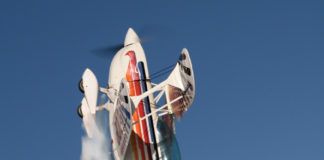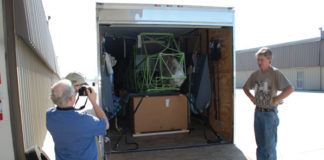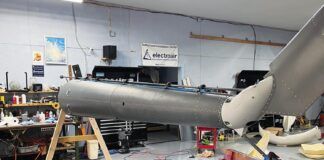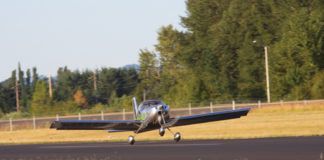Last month we took a look at several coupled lateral/directional modes of airplane motion. Adverse yaw, the tendency of an airplane to yaw one way when the pilot commands a roll the other was the first. Because adverse yaw is so significant to the flying qualities of airplanes, we will take a closer look at it this month.
To fly an airplane, the pilot must be able to control it about three axes: longitudinal (pitch), lateral (roll) and directional (yaw). Ideally, control of each axis should be independent of the others, and be effected by a single control motion. A rudder pedal input should cause the airplane to yaw, but not pitch or roll. An elevator input (stick forward or back) should cause the airplane to pitch, but not roll or yaw, and a lateral input (stick left or right) should cause the airplane to roll, but not yaw or pitch.
In practice, some axes are easier than others to control without cross-coupling into other axes. On most airplanes, pitch inputs have little or no tendency to couple into other axes. As we have already seen, motion about the yaw and roll axes tends to be coupled. For most airplanes, an initial rudder input produces a nearly pure yawing moment. When the airplane yaws, however, the combination of the sideslip cause by the yaw and dihedral effect causes the airplane to roll as well as yaw.
Roll commands are the most problematic. While the elevators and rudders of most airplanes produce nearly pure moments about their respective axes, most roll-control devices (ailerons and sometimes spoilers) produce yawing moment as well as rolling moment when they are deflected.
Adverse Yaw
A pilot who pushes the stick laterally is attempting to command a pure roll. Unfortunately, the aerodynamics of the airplane are uncooperative. Deflecting the ailerons will often cause yaw as well as roll. For most airplanes, this yaw is in a sense opposite to that of the roll. If the stick is pushed to the left, the airplane will roll left-wing-down, and yaw nose-right. This phenomenon is called adverse yaw, as the yaw is in the opposite direction to the roll.
The Wright brothers were the first experimenters to understand that airplanes should be turned by rolling them into a bank rather than trying to make them yaw around a turn. They developed their system of wing warping to give their aircraft the necessary roll control. When they started testing gliders using their new roll control, they also quickly discovered adverse yaw. At first, these
gliders had no vertical surfaces at all. When they were first tested as kites, with the ropes constraining yaw, the wing warping appeared to work well. In free flight the brothers discovered that, though the warping did roll the glider, it didn’t cause it to turn the way they had hoped. When they warped the wings, the glider initially rolled the way they wanted it to, but it didn’t point its nose into the turn and tended to try to fly sideways. Sometimes it even turned the wrong way. They realized relatively quickly that the wing warping was causing yawing moment as well as rolling moment, and modified the configuration of their machines to account for this effect. Their 1902 glider had a vertical surface mounted aft on booms, and the 1903 Flyer incorporated a biplane all-moving rudder assembly to counteract the adverse yaw. Adverse yaw continues to be an issue today. On some swept-wing airplanes, the combination of adverse yaw and high dihedral effect due to sweep can be so powerful that the initial response of the airplane to a pure aileron input can be a turn in the opposite direction.
Aerodynamics of Adverse Yaw
Aileron parasite drag: There are multiple aerodynamic causes of adverse yaw. First, deflecting a simple aileron down usually increases the parasite drag of a wing more than deflecting the same aileron up an equal amount. If the ailerons are deflected equal and opposite amounts, the parasite drag of the wing with the down-deflected aileron will be higher than that of the wing with the up-deflected aileron. This difference in parasite drag is the most commonly cited cause of adverse yaw. In fact, while it contributes, there are other effects that are stronger. Even if the ailerons produced no change in the wing parasite drag when deflected, there would still be adverse yaw.
Induced drag: The second effect contributing to adverse yaw is the change in induced drag between the two wings. To roll the airplane, the ailerons increase the lift of the wing we wish to raise and decrease the lift of the opposite wing. The increased lift on the rising wing increases its induced drag, while the decreased lift on the descending wing decreases its induced drag.
Deflecting the ailerons changes the distribution of lift on the wings. The centroid of lift on the wing with the down aileron is moved outboard. On the wing with the up aileron it moves inboard. The change in the lift distribution also changes the centroid of the induced drag of the wing panels. The drag moves spanwise with the lift. This moves the centroid of the induced drag toward the up-going wing and causes the airplane to yaw in that direction.
This induced drag difference occurs even when the mechanism for changing lift is not ailerons. As we have seen, the Wright brothers encountered adverse yaw on their early gliders that had wing warping for lateral control. It was adverse yaw that led them to put a moveable rudder, geared to move simultaneously with the wing warp on their powered Flyer. A similar effect has been observed on some radio-controlled model gliders that change the incidence of the two wing panels for roll control.
Induced drag is proportional to the square of the lift coefficient. Because of this, the differential-induced-drag contribution to adverse yaw increases as the airplane is flown slower and at a higher lift coefficient. This phenomenon contributes significantly to the stall/spin problem, particularly on older airplanes. If the pilot attempts to pick up a wing with the ailerons when the airplane is flying at or near the angle of attack for stall, adverse yaw can cause the airplane to yaw toward the down wing and initiate a spin entry. Once in the spin, the adverse yaw and gyroscopic effects of anti-spin aileron deflection can delay or even prevent recovery.
Effect of Roll Rate
The two causes of adverse yaw that we have just discussed (aileron drag and induced drag differences between the wings) are static effects. That is, the adverse yaw is present before the airplane starts rolling-it appears the moment that the aileron deflection is applied.
However, there is also a dynamic component: adverse yaw due to roll rate. If a lifting wing is forced to roll, it will generate adverse yaw even if the rolling moment is being caused by some other part of the airplane (e.g., a rolling tail). The adverse yaw is an effect of the way the roll rate changes the angle at which the airflow arrives at each of the wing panels. On the down-going wing, the roll rate causes the airflow to arrive at a greater upward angle than the free stream, while on the up-going wing the opposite is true. The lift of a wing acts at 90 to the oncoming airflow. The change in inflow angle due to roll rate rotates the lift vector of the down-going wing forward, and of the up-going wing aft. This causes a yawing moment in the direction of the up-going wing.
This effect is particularly significant for airplanes where the difference in inflow angle caused by roll rate is large. The helix angle described by the wingtip through the air is proportional to the roll rate multiplied by the wingspan. Accordingly, adverse yaw due to roll rate is most pronounced on airplanes that roll very fast (such as fighters and aerobatic airplanes) and airplanes with large wingspans (sailplanes).
There are multiple causes of adverse yaw. There are also multiple ways to reduce adverse yaw, and give the pilot a way to control it. Next month, we will look at some of these design solutions to the problem.
Barnaby Wainfan is a principal aerodynamics engineer for Northrop Grummans Advanced Design organization. A private pilot with single engine and glider ratings, Barnaby has been involved in the design of unconventional airplanes including canards, joined wings, flying wings and some too strange to fall into any known category.













